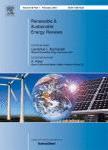版权所有:内蒙古大学图书馆 技术提供:维普资讯• 智图
内蒙古自治区呼和浩特市赛罕区大学西街235号 邮编: 010021

作者机构:Mohammed V Univ Rabat Natl Higher Sch Arts & Crafts ERERA Rabat Morocco
出 版 物:《RENEWABLE & SUSTAINABLE ENERGY REVIEWS》 (Renewable Sustainable Energy Rev)
年 卷 期:2025年第212卷
核心收录:
学科分类:0820[工学-石油与天然气工程] 080703[工学-动力机械及工程] 08[工学] 0807[工学-动力工程及工程热物理]
基 金:Ministry of Higher Education, Scientific Research and Innovation Digital Development Agency (DDA) CNRST of Morocco [Alkhawarizmi/2020/39]
主 题:Building automation Microgrids Active and reactive power dispatch strategy Metaheuristic Optimization Algorithm Moroccan Tiered Electricity Tariff Time of Use Tariff Battery storage
摘 要:This research introduces an innovative Active and Reactive Energy Management System (AR-EMS) of a Smart Microgrid (SMG) supplying various types of consumers and using different pricing schemes. The research explores the electricity pricing and the regulations in force impacts on energy flow distribution, bill and Storage System (SS) lifespan. It compares two pricing tariffs: the Moroccan tiered pricing system (TTS) and the European Time-of-Use (TOU) tariff. The proposed AR-EMS calculates optimal active and reactive power setpoints for each energy source over 30 days, using load consumption and photovoltaic (PV) power forecasts. The optimization problem is solved using particle swarm optimization (PSO), aiming to simultaneously reduce the energy cost, SS degradation, Peak-to-Average Ratio (PAR), and environmental impact. Experimental validation is conducted with real data from a lab in Rabat, Morocco. The research critically analyzes and compares the performance of the proposed AR-EMS with an existing industrial Active Energy Management System (A-EMS). The study also highlights the potential earnings by enabling excess energy to be injected into the Moroccan grid. The robustness and scalability of the proposed AR-EMS are validated using industrial consumer data. Comparative analysis reveals several advantages of the AR-EMS with respect to the considered industrial A-EMS, including a 6% reduction in energy costs, a 73% decrease in PAR, and a 17% reduction in carbon emissions while improving the power factor by 31%. Finally, when applied to the industrial consumer data, the proposed solution demonstrates robustness and advantages results.